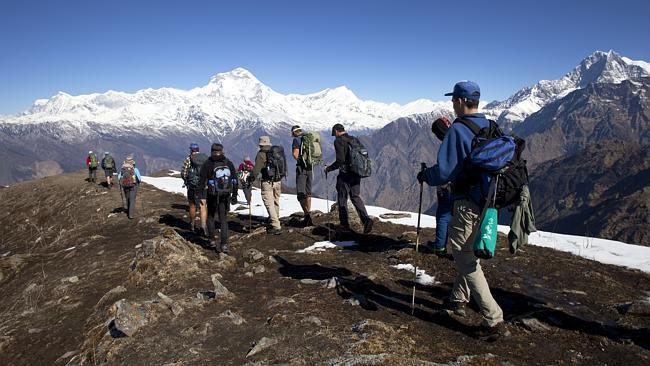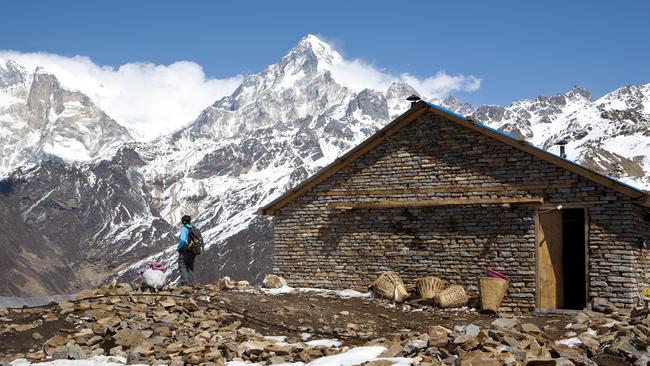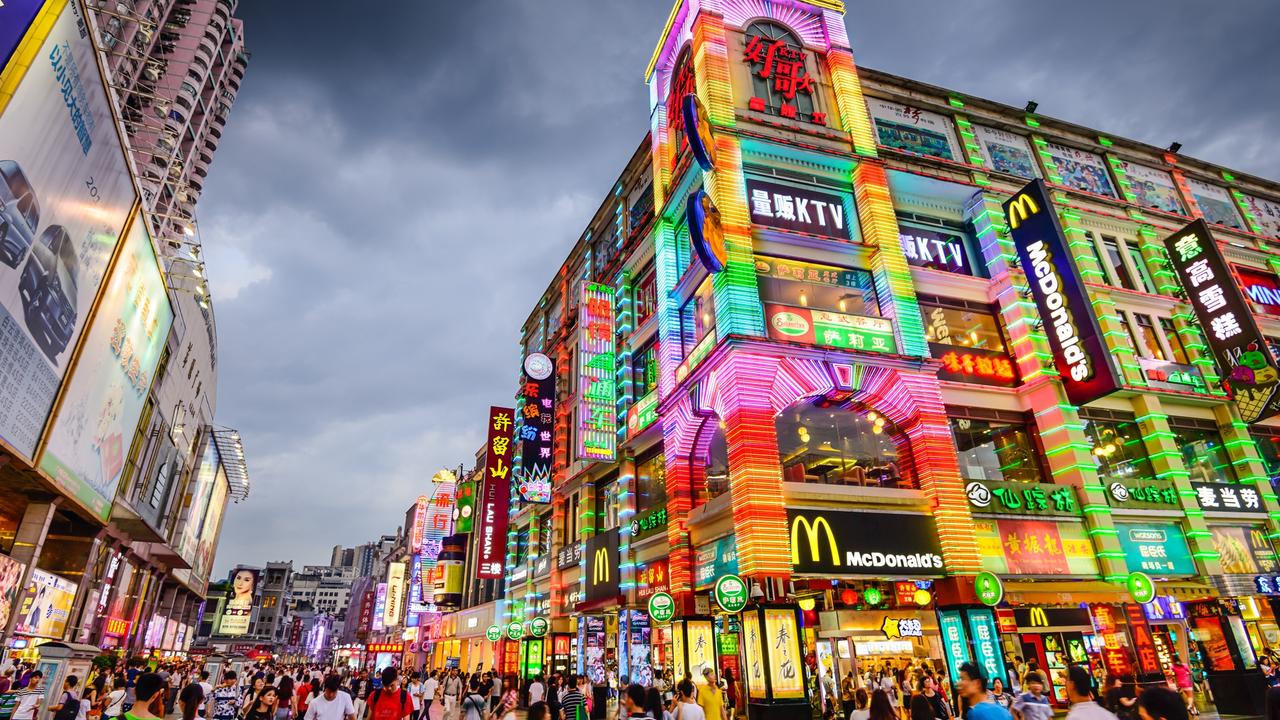Discover new eco-lodges and campsites on Nepal’s humbling Annapurna trek
RECENTLY opened eco-lodges, campsites and uncrowded trails make this one of Nepal’s most majestic trekking experiences.

Asia
Don't miss out on the headlines from Asia. Followed categories will be added to My News.
THEY say the lack of oxygen at altitude is most noticeable above 3000m. Ahead, our Himalayan campsite sits beneath a ridge that’s 400m higher than that. It’s a rise of 800m from where we stayed the previous night, at a guesthouse in Tadapani, so I expect to suffer from shortness of breath. And to complicate matters, snow has fallen constantly throughout the afternoon.
At times I find myself sinking up to my knees in thick, fresh snow, and more than once my feet slide out from under me.
The higher we climb, the more laboured my breathing becomes. On my previous trip to Nepal, I reached an altitude of 6500m – almost double the height of our camp tonight. But that was 14 years ago, when I was younger, fitter and far better acclimatised. By the time I crossed the 3400m mark then, I’d already been trekking for two weeks. And it would ultimately take me a month to summit Mera Peak.
This time, World Expeditions has scheduled just eight days of trekking, following a non-commercialised route through the Annapurna Conservation Region. Our goal is to reach Kopra Ridge, an isolated crest running from the upper slopes of the mighty Annapurna South down into the Ghar Khola Valley. It’s on this ridge that World Expeditions opened its first eco-lodge in this region, in January this year.

For the first four days, we followed the popular Annapurna Base Camp trail to Tadapani, passing through mountain villages clinging determinedly to terraced slopes and overnighting in eco-friendly lodges or World Expeditions’ own permanent campsites.
The campsites are also new additions to this area, following on from the success of a similar initiative that they pioneered in the Everest region in early 2011.
Typical teahouses and campgrounds burn wood for cooking and heating, contributing to deforestation and consequently increasing the risk of landslides.
World Expeditions realised that it could minimise the impact its trekking groups were having on the environment by using only kerosene and yak dung stoves. Stone, cement and tin are also used in preference to wood as building materials, with necessary timbers sourced from sustainable forests. Rainwater is also collected in tanks.
This morning, after we set off from Tadapani, we deviate from the beaten track to hike along uncrowded trails, climbing steadily into what our Sherpa guide Rinzin called “the hills”. “You call them mountains,” he added, chuckling at the perceptual disparity. From here on in, he promised, we could bid farewell to wireless internet access, souvenir stalls and apple pies. And we could rid our minds of thoughts about sharing the trails with other trekkers too.
“It’s likely we’ll be all alone,” he said.
On that, he proved accurate. But he was far from correct when he’d looked towards the heavens last night and predicted almost perfect conditions for trekking. “There is a 90 per cent chance of no rain falling,” he declared. How wrong he was.

I dressed in shorts and a T-shirt for our morning’s hike, and sweat dripped down my face and back as we climbed through flowering rhododendron forests. Then, over lunch, the clouds swept in from the south, forcing temperatures to plunge into subzero territory.
Soon enough, it began to snow and we rummaged through our packs for extra layers of clothing.
I sleep brilliantly that night, perhaps from exhaustion, and when I poke my head outside the tent the next morning, I discover plenty of fresh snow on the ground.
When the sun casts its warming glow across the valley, the clouds lift just enough so that we can see across to Kopra Ridge. It sits above the tree line, bare and exposed. That morning’s hike is the prettiest of the trek. We march through virgin snow, following an old hunting trail to a frozen waterfall suspended in time. Trickling from it is a stream – the Ghar Khola in its infancy – dividing the northern slope we’ve been traversing from the ridge’s barren eastward face.
By mid-morning, we’re hiking through yak pastures to Kopra Ridge. Across the valley, a radio tower is visible atop Poon Hill and the Dhaulagiri Massif tries desperately to poke its brow through lingering clouds to our northwest. Lammergeiers, or bearded vultures, float on the updrafts directly above us.
Our lodge’s location is ridiculously scenic, perched on the ridge beneath the pyramidal summit of Annapurna South. To its west, the almost vertical southern face of Fang forms a stepping stone to Annapurna I.

The 10th-highest mountain on the planet slopes down into its deepest gorge, the Kali Gandaki Valley, which is bookended on its opposite flank by the hulking Dhaulagiri Massif, the world’s sixth highest peak.
Somewhere above us, out of view, is Khayer Lake. Twice yearly, pilgrims trek to this remote alpine tarn to pray and drink warm blood from a yak in the belief that it will heal troublesome maladies. It’s an 11-hour return hike there from our lodge, along that same pilgrim route, and we’re meant to attempt it tomorrow.
But the heavy snow cover has given Rinzin cause to rethink. He doubts we’d be able to make it all the way. And that even if we did, the going would be too tough for us to enjoy it. To be honest, I’m not overly fussed about whether we do it or not, content instead to drink in the views from where I stand.
Mark Daffey travelled to Nepal as a guest of World Expeditions.
GO2
NEPAL
GETTING THERE
There are no direct flights to Nepal and transfer delays vary. China Southern (www.csair.com/en) offers the quickest connections and cheapest fares, from around $950 return in October, via Guangzhou. Malaysian (www.malaysianairlines.com) or Thai (www.thaiairways.com) are also competitive.
STAYING THERE
Kathmandu’s Radisson Hotel (www.radisson.com/kathmandu-hotel-np/nepkathm) has a dedicated staff member who looks after the needs of World Expeditions guests. Rates start from around $150 per night. World Expeditions also has its own permanent campsite in Pokhara — gateway to the Annapurna and Dhaulagiri regions.
MORE
World Expeditions offers several Annapurna and Dhaulagiri region treks that include hiking to Kopra Ridge. Several are designed to celebrate the company’s 40th anniversary in Nepal. The trekking season goes from October-April. Call toll free 1300 720 000 or look up www.worldexpeditions.com for further information.
World Expeditions completed an assessment of the Annapurna and Everest regions following the devastating earthquake in April this year. They report that the trails in both regions are undamaged and that trekking will resume as usual in September.
Originally published as Discover new eco-lodges and campsites on Nepal’s humbling Annapurna trek


